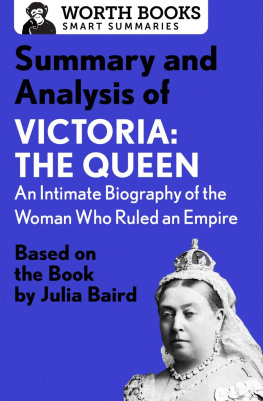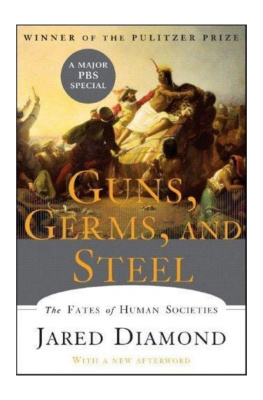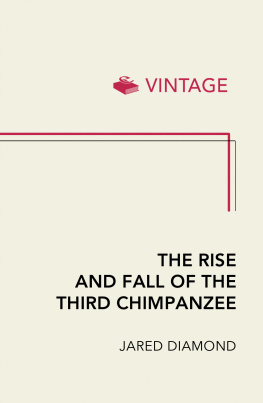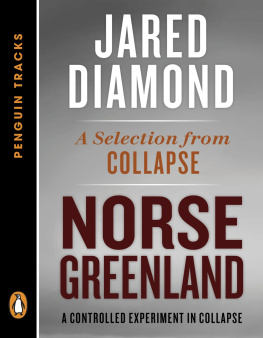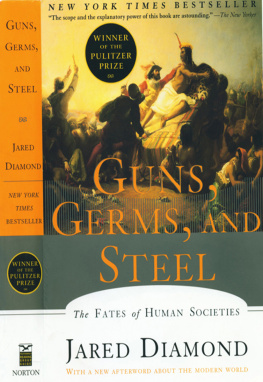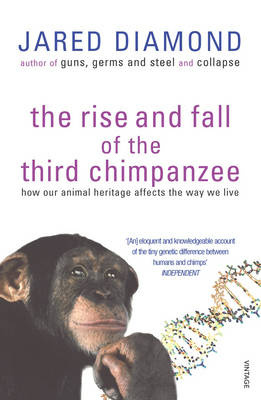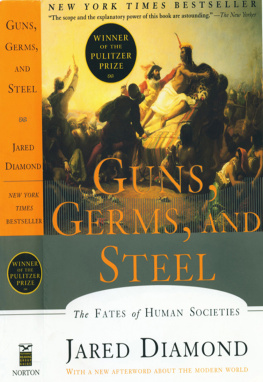The summary and analysis in this ebook are meant to complement your reading experience and bring you closer to a great work of nonfiction. This ebook is not intended as a substitute for the work that it summarizes and analyzes, and it is not authorized, approved, licensed or endorsed by the works author or publisher. Worth Books makes no representations or warranties with respect to the accuracy or completeness of the contents of this ebook.
Summary and Analysis of
Guns, Germs, and Steel
The Fates of Human Societies
Based on the Book by Jared Diamond

Contents
Context
Jared Diamond wrote Guns, Germs, and Steel partly to refute familiar, racist explanations for the political and cultural dominance of European and Asian societies over others. According to Diamond, the old rhetoric of civilized people (usually Eurasians) versus savages (usually non-Eurasian indigenous peoples) was fallacious.
In a 2004 interview with PBS, the fundamental question Diamond was looking to address was why history unfolded differently on the different continents over the last 13 thousand years.
In his search for the ultimate causes of Eurasian dominance, Diamond chose to focus on two often-overlooked areas of history: the history of non-Eurasian native societies, and human history before 3000 BCE. The prehistory of indigenous societies, argued Diamond, can shed light on the deeper reasons for modern historys course. Guns, Germs, and Steel , published in 1997, offered a new perspective on human history, one that placed geography and ecology, rather than biology, at the forefront of human history.
The book has since been translated into more than twenty-five languages, has sold millions of copies, inspired a three-hour program produced by National Geographic and PBS, and won a Pulitzer Prize for general nonfiction.
With the success of this work, and his impressive decades-long background in research and academia, Jared Diamond is now revered by many as a thought leader beyond the spheres of societal evolution, anthropology, geology, and the history of innovation. He is a sought-after speaker who can be found addressing non-academic audiences from a variety of platforms, including TED Talks, the Long Now Foundation, Talks at Google, and at a diverse range of schools and institutions.
Overview
When Spanish conquistadors first came to the New World, they did not find empty wilderness: There were millions of people there, with distinct languages and cultures. The Spanish were vastly outnumbered and totally isolated; interlopers in a foreign place. When General Francisco Pizarro encountered the Inca emperor Atahuallpa in 1532, he was one of only 168 soldiers facing eighty thousand Inca warriors, deep within the Incan empire. Yet Pizarro and his forces managed to capture Atahuallpa and slaughter more than seven thousand Inca soldiers within hours of their meeting. And within one hundred years of Columbus discovery of the New World in 1492, the vast empires of the Inca, Maya, and Aztec had collapsed, and the population of the Americas had plummeted by ninety-five percent.
The Spanish conquest of the Americas is a familiar story, one thats quite similar to collisions between colonial powers and native peoples throughout the modern world, from the Chinese invasion of Taiwan to the Dutch settlement of South Africa and the British annexation of Australia. Out of this broad historical pattern, Jared Diamonds Guns, Germs, and Steel: The Fates of Human Societies draws a series of questions: Why were the Spanish able to defeat the Inca, and the British rout the Aborigines? Why have Europeans and Asians historically triumphed over the indigenous people of other continents? Why werent the Australians, Americans, and Africans the ones who colonized Europe?
The immediate causes of Eurasian victories seem obvious. Europeans and Asians had advanced weaponry, immunity to the diseases that decimated native populations, and metal technologiesthe titular guns, germs, and steelthat the conquered peoples did not have. But as Diamond points out, this explanation often suggests an ugly underlying assumption: Europeans were inherently superior to the people they enslaved or exterminated, and European technological and political advantages were symptoms of their biological ascendancy. With Guns, Germs, and Steel, Diamond sets out to dismantle racist explanations for Eurasian dominance by following what he calls chains of causation to identify the ultimate causes of historys evolutionoutcomes which, asserts Diamond, spring from determinants within human environments, not human biology.
The literal and figurative roots of Eurasian dominance lie in the Eurasian continent itself. After a sweeping tour of human evolutionary and migratory history, from the beginnings of Homo sapiens to the human migration to the Americas in 12,000 BCE, Diamond trains his focus on the Fertile Crescent, a region in southwestern Asia where humans established the first farming societies. In the 9th century BCE, the Fertile Crescent was home to a panoply of domesticable wild grasses and mammals in an abundance unparalleled on any other continent. (Eurasians domesticated cows, sheep, dogs, goats, and horses, whose wild ancestors were native to the continent; in the Americas, the alpaca was the only domesticable native animalhorses arrived later with the Spanish.) Through the gradual and largely accidental process of plant and animal domestication, Eurasians formed the first farming societies.
With farming came more food per square mile, and with more food came more people. High population density led to the establishment of strong leaders and social classes. Among these social classes were soldiers, artists, and bureaucrats, who were freed from the obligations of farming and could instead devote themselves to waging war, making art, and inventing new technologies. Because Eurasias major axis runs east to west, adjacent regions enjoyed similar climates and growing seasons, which allowed crops and technology to diffuse out of the Fertile Crescent and across the continentto western Europe, for instance, where food production never emerged independently.
The same ease of diffusion lies behind the spread of written language, which only a very few food-producing societies invented without getting the idea from somewhere else. Because the Eurasian continent facilitated it, Eurasian societies exchanged goods and ideas and built off the innovations of their neighbors. The Europeans head starts on agriculture and writing were not a matter of innate genius, nor did they result from hard work or particularly receptive cultural attitudes. European societies advanced through the happenstance of Eurasian geography and ecology.
Similar coincidences of environment account for the ravaging spread of disease among the native peoples of Australia, parts of Africa, and the Americas. The most devastating human diseases of the modern world originated from domestic animal hosts: Smallpox, tuberculosis, and measles originated in cows, while influenza first appeared in pigs. The dense populations of agricultural societies also expedited the spread of epidemicsgerms spread best in crowds.
Because many of the animals that might have been domesticated by the indigenous peoples of Africa, Australia, and America were hunted to extinction when early hunter-gatherers first migrated there, the natives of those continents never had a chance to develop immunity to animal-borne illnesses. Had there been domesticable animals on those continents, then native African, Australian, and American pathogens might have devastated European populations, making the European conquest difficult or impossible.
Next page





